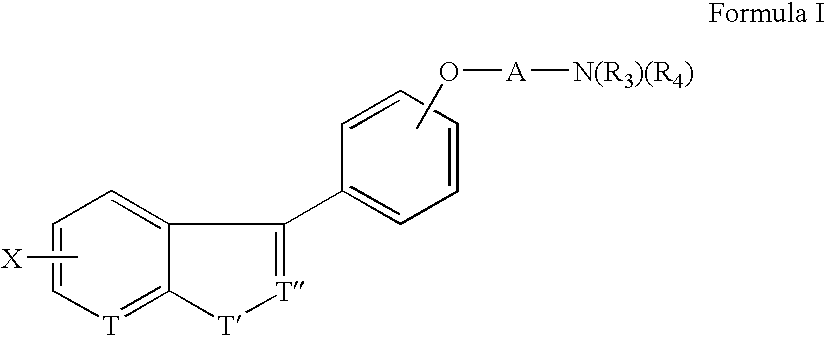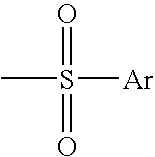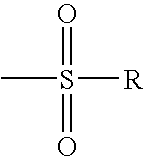Benzisoxazolyl-, pyridoisoxazolyl-and benzthienyl-phenoxy derivatives useful as D4 antagonists
a technology of pyridoisoxazolyl and benzthienylphenoxy, which is applied in the field of benzisoxazolyl, pyridoisoxazolyland benzthienylphenoxy derivatives useful as d sub > 4 /sub > antagonists, can solve the problems of not usually meeting criteria, functional implications of this lower affinity are not yet resolved, and no specific data regarding gene frequency is availabl
- Summary
- Abstract
- Description
- Claims
- Application Information
AI Technical Summary
Benefits of technology
Problems solved by technology
Method used
Image
Examples
example 1
MDL 814608A
Synthesis of 6-fluoro-3-[4-(3-piperidin-1-yl-propoxy)-phenyl]-benzo[d]isoxazole hydrochloride (Scheme IV, Compound 1c)
Scheme IV, Step S
Synthesis of 1-(3-phenoxy-propyl)-piperidine (Scheme IV, Compound 4)
[0165]
[0166]Mix 3-phenoxypropyl bromide (801.5 g, 3.73 mol), potassium iodide (61.8 g, 0.37 mol, 0.10 equivalents) and water (4.0 L) in a 12-L, 3-necked flask fitted with: a stirrer, thermometer in a side-arm adapter, connected to a Firestone® valve and an addition funnel fitted with a gas outlet adapter, connected to a bubbler. Add piperidine (634.6 g, 7.45 mol, 2.0 equivalents) over 1 hour, without cooling under nitrogen. The temperature at the end of the addition is 40° C. Heat the reaction mixture and maintain the temperature at 50° C. for 6 hours. Monitor the progress of the reaction by HPLC (Column=300×3.9 mm Phenomenex Bondclone 10 CN; mobile phase=65% acetonitrile:35% 0.1N ammonium formate buffer; flow=1.5 mL / minute; wavelength=215 nm; RT: 3-phenoxypropyl bromide=2...
example 2
MDL 813866
Synthesis of (S)-1-[4-(6-fluoro-benzo[d]isoxazol-3-yl)-phenoxy]-3-[(thiophen-3-ylmethyl)-amino]-propan-2-ol maleate (Scheme III, Compound 1 and Scheme V, Compound 1e)
Scheme I, Step D and Scheme V, Step W
Synthesis of (2,4-difluoro-phenyl)-(4-methoxy-phenyl)-methanone (Scheme I, Compound and Scheme V, Compound 4)
[0172]
[0173]Combine 2,4-difluorobenzoyl chloride (227.8 g, 1.29 mol), anisole (154.2 mL, 1.42 mol) and 1,2-dichloroethane (2.28 L) and cool (−3° C.) under a nitrogen atomosphere. Add aluminum chloride (209.8 g, 1.57 mol) over 45 minutes. The solution color turns from clear to yellow. Pour the reaction mixture over a mixture of ice (1700 g) and concentrated HCl (640 mL) over 2 minutes. The color of the mixture turns from yellow to clear. Separate layers and wash organic layer with 10% potassium carbonate (1600 mL), water (1600 mL), dry (MgSO4), filter and concentrate to give a solid. Stir the solid in heptane (960 mL) and filter to give the title compound as a white s...
example 2a
Synthesis of thiophen-3-yl-methylamine (Scheme V, Compound 12)
Scheme V, Step B′
Synthesis of thiophene-3-carbaldehyde oxime (Scheme V, Compound 11)
[0190]
[0191]Dissolve hydroxylamine hydrochloride (725 g, 10.43 mol) in pyridine (3 L), which causes an exotherm (23-30° C.). Cool (25° C.) the reaction mixture, under nitrogen and add 3-thiophenecarboxaldehyde (585 g, 5.2 mol) over ˜1 hour while maintaining the temperature from 22-27° C. Concentrate (60° C. / 50 torr) the reaction mixture to an oily residue and partition between ethyl acetate (2 L) and water (1 L). Extract the organic layer with 1 N HCl (2×600 mL), followed by water (3×500 mL). Dry (MgSO4), filter, wash the solid with ethyl acetate (500 mL) and concentrate (60° C. / 60 torr) to give the title compound as a semi-solid residue (575 g, 99% Yield: 1H NMR (CDCl3, 200 MHz) δ 7.3-7.55 (m, 3H), 8.2 (s, 1H), 8.7-9.2 (br s, 1H).
Scheme V, Step C′
Synthesis of thiophen-3-yl-methylamine (Scheme V, Compound 12)
[0192]
[0193]Add a solution of t...
PUM
| Property | Measurement | Unit |
|---|---|---|
| time | aaaaa | aaaaa |
| time | aaaaa | aaaaa |
| time | aaaaa | aaaaa |
Abstract
Description
Claims
Application Information
 Login to View More
Login to View More - R&D
- Intellectual Property
- Life Sciences
- Materials
- Tech Scout
- Unparalleled Data Quality
- Higher Quality Content
- 60% Fewer Hallucinations
Browse by: Latest US Patents, China's latest patents, Technical Efficacy Thesaurus, Application Domain, Technology Topic, Popular Technical Reports.
© 2025 PatSnap. All rights reserved.Legal|Privacy policy|Modern Slavery Act Transparency Statement|Sitemap|About US| Contact US: help@patsnap.com



